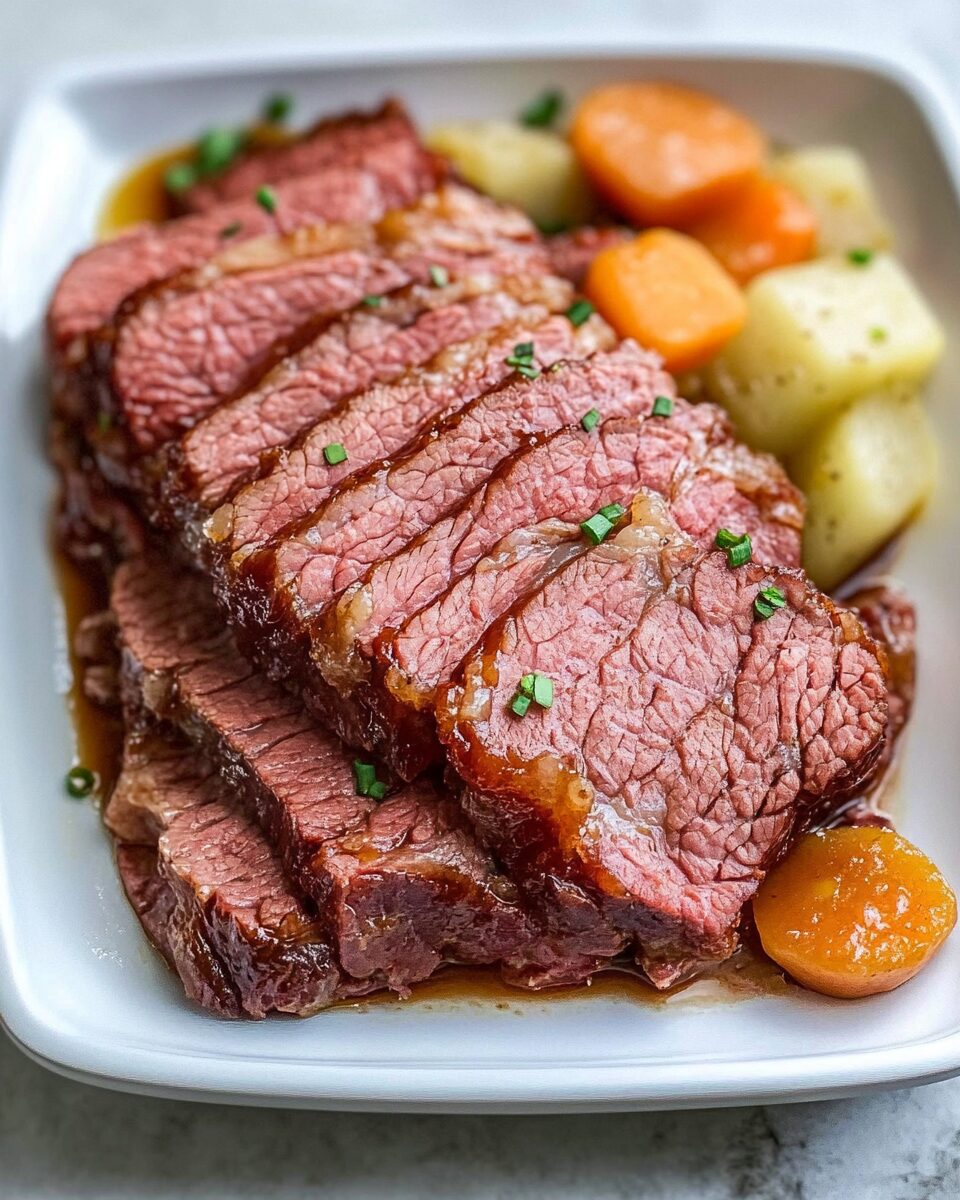low Cooker Corned Beef and Cabbage is a comforting and hearty meal, perfect for celebrating St. Patrick’s Day or enjoying a cozy family dinner. The slow cooking process ensures tender, flavorful meat, complemented by the soft, seasoned vegetables. This one-pot dish is simple to prepare and brings a rich, traditional taste to your table.
FULL RECIPE
Ingredients
- Corned beef brisket
- Potatoes
- Carrots
- Cabbage
- Onion
- Garlic
- Beef broth
- Water
- Bay leaves
- Black peppercorns
- Dijon mustard
Directions
- Place the corned beef brisket in the slow cooker, fat side up.
- Add the garlic, onion, bay leaves, and peppercorns.
- Pour in the beef broth and enough water to cover the meat.
- Cook on low for about 8 hours, or until the meat is fork-tender.
- Halfway through the cooking process, add the potatoes and carrots.
- About an hour before the corned beef is finished, add the cabbage wedges to the slow cooker.
- Remove the cooked corned beef and let it rest for a few minutes before slicing.
- Serve with the vegetables and a drizzle of the flavorful cooking broth.
- For an extra touch, spread Dijon mustard on the side for dipping.
Nutrition Facts
- Calories: 450 per serving
- Protein: 40g
- Fat: 20g
- Carbohydrates: 30g
- Fiber: 6g
- Sodium: 1400mg
Flavor and Texture Profile
Slow Cooker Corned Beef and Cabbage boasts a rich, savory flavor enhanced by the tender, fall-apart texture of the meat. The spices used in the brine, typically including peppercorns and bay leaves, infuse the meat with a slightly tangy and aromatic taste. The slow cooking process allows the beef to soak in all the broth and spices, resulting in a melt-in-your-mouth texture. Complementing the meat are the vegetables, which become tender and absorb the delicious cooking broth. The cabbage, in particular, takes on a slightly sweet and buttery flavor, while the carrots and potatoes offer a creamy and earthy contrast. Adding a touch of Dijon mustard when serving introduces a mild, tangy bite that cuts through the richness of the beef.
Variations and Substitutions
There are numerous ways to customize corned beef and cabbage to suit different dietary preferences. For a lower sodium version, soak the corned beef in water for a few hours before cooking to reduce the salt content. If you prefer a gluten-free meal, ensure that the broth and mustard used are gluten-free certified. For added sweetness, you can include parsnips or sweet potatoes alongside the carrots and potatoes. Vegetarians can try a plant-based version using seitan or jackfruit, seasoned with traditional spices to mimic the corned beef flavor.
Historical Background
The origins of corned beef date back centuries, with the name derived from the large grains or “corns” of salt used in the curing process. While corned beef was historically popular in Ireland, it was often too expensive for the average household. Irish immigrants in America found corned beef more accessible, particularly from Jewish butchers in cities like New York. It quickly became a staple dish, especially during Irish-American celebrations.
Health Considerations
While corned beef and cabbage is rich in protein and essential nutrients, it is also high in sodium and saturated fat. Moderation is key, particularly for individuals managing high blood pressure or heart health. To make the dish healthier, consider trimming excess fat from the brisket and using low-sodium broth. Adding extra vegetables, such as celery, turnips, or leeks, can further boost the fiber and nutrient content.
Popular Side Dishes
Beyond Irish soda bread, other popular side dishes to serve with corned beef and cabbage include roasted Brussels sprouts, creamy mashed potatoes, or buttered green beans. A tangy coleslaw can provide a refreshing contrast, while a homemade applesauce adds a touch of sweetness to balance the savory flavors. For dessert, traditional Irish treats like bread pudding or an apple tart can complement the meal beautifully.
Cultural Significance
Corned beef and cabbage is often associated with St. Patrick’s Day celebrations in the United States, although it is not a traditional dish in Ireland. The dish emerged from Irish-American communities who adapted their meals to the ingredients available in America. In Ireland, bacon and cabbage were more common, but upon immigrating to the U.S., corned beef became a more affordable and accessible alternative. The pairing of cabbage and potatoes, staples in both Irish and American diets, added a hearty and economical complement to the meal. Today, it remains a symbol of Irish heritage and is widely enjoyed during festive gatherings.
Tips for the Perfect Corned Beef and Cabbage
Achieving the perfect slow-cooked corned beef requires a few essential tips. First, choosing a well-marbled brisket will ensure tender and juicy results. Cooking the meat fat-side up allows the fat to render and naturally baste the meat throughout the cooking process. Additionally, adding the vegetables at the right time is crucial. Potatoes and carrots should be introduced halfway through to prevent them from becoming overly mushy, while cabbage benefits from a shorter cooking time to retain its texture and subtle sweetness. Using beef broth instead of water adds a richer depth of flavor to the dish, and a splash of apple cider vinegar or beer can further enhance the taste.
Serving Suggestions
Corned beef and cabbage pairs beautifully with traditional Irish soda bread, which has a slightly sweet and dense texture. The bread is perfect for soaking up the flavorful broth from the dish. For added freshness, consider serving the meal with a side of whole-grain mustard or horseradish sauce. A crisp green salad with a light vinaigrette can also provide a refreshing contrast to the richness of the meat. If you’re celebrating St. Patrick’s Day, complement the meal with a pint of Irish stout or a glass of whiskey to complete the festive experience.
Storage and Reheating
Leftover corned beef and cabbage stores well in the refrigerator for up to four days when kept in an airtight container. To reheat, place the meat and vegetables in a baking dish with a bit of the cooking broth to retain moisture, then cover and warm in a preheated oven at 300°F until heated through. Alternatively, leftovers can be repurposed into delicious meals such as corned beef hash, sandwiches, or a savory breakfast skillet.
Conclusion
Slow Cooker Corned Beef and Cabbage is a quintessential comfort food that brings warmth and satisfaction to any table. Its hearty flavors, tender texture, and cultural significance make it a cherished dish, particularly during celebrations like St. Patrick’s Day. With its simple preparation and delicious results, this meal is perfect for both special occasions and family dinners. Whether enjoyed fresh from the slow cooker or transformed into creative leftovers, corned beef and cabbage remains a timeless classic that continues to bring people together over a shared love of good food.






